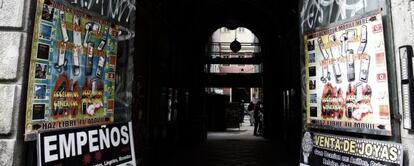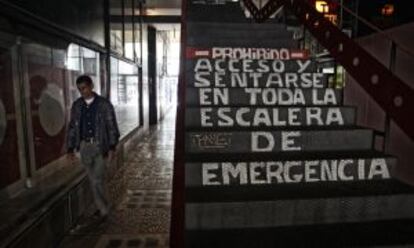Madrid's lost arcades
These old commercial cloisters were once the life and soul of the Spanish capital Now that they are in decline, a new movement is afoot to revitalize the shopping galleries


The first covered arcades were built in Paris in the early years of the 19th century, when the French capital was still considered the world's cultural center and the intellectual hub of the West. They were elegant, bustling places, built using marble, glass, and wrought iron, and were among the first places to be fitted with gas lamps. They housed up-scale shops, as well as cafés that attracted intellectuals. The arcades of Paris soon came to be seen as symbols of modern city life. And as with so many French inventions, they soon spread to other cities in Europe, among them Madrid.
The first arcades were built during the 25-year reign of Isabel II, which began in 1843, a time when the Spanish capital was growing quickly, thanks in large part to policies that allowed for the hundreds of convents and monasteries in Madrid to be demolished, which in turn sparked a construction boom. The area around what is today the Puerta del Sol quickly established itself as the city's commercial and leisure center.
"After the French Revolution, the city was no longer under the control of the king, passing instead to the bourgeoisie. Arcades are the first private initiatives that changed the city," says Carlos Sambricio, a professor of History and Urban Architecture at Madrid's Polytechnic University. "In Madrid, this marks a break with the medieval city, a move away from old ideas of commerce, and the beginning of what would become the modern city; and they won."
In Paris, several arcades have been refurbished and restored
"These arcades brought together different shops, helped pedestrians move around the city, and created leisure spaces for shops, galleries, and theaters," says historian Carmen del Moral of Madrid's Complutense University, who is the author of a study of the capital's arcades. "They can be seen as a precursor of our current shopping malls, as they were usually located close to the big department stores and other shops in the city center," she adds.
The majority of the arcades built in mid-19th century Madrid are long gone, among them the Iris, Jordá, and the Exportación Comercial, while those constructed in the 20th century retain little of their bourgeois splendor. The few that remain are no longer used as shortcuts, and are often seedy, ill-lit places, usually associated with sex shops, gold dealers, or watch repairers, with many establishments closed up and only the dusty, faded signage giving any indication of their former life.
But in Paris, arcades such as the Vivienne, Choiseul, or des Panoramas (which inspired German intellectual and exile Walter Benjamin to set up his Arcades Project in 1927), have been refurbished and restored, and now house shops and cafés, as they were originally intended to do. As in London, which is also home to many buildings, the Parisian authorities have created tourist trails based on the city's arcades. So what happened in Madrid?

"When the bourgeoisie start to move out of the center of the city to settle in the suburbs, or new districts such as the Salamanca neighborhood, setting up their stores there, the arcades were taken over by poorer shop keepers, and thus began their decline," says Sambricio. Climate probably also played a part in the process, says Del Moral: "The arcades make a lot of sense in cold and rainy climates, because they offer a place of refuge from the elements, but Madrid's climate encourages people to be outdoors, and the city has a street life that few others can match."
Not that all is lost. A new generation of entrepreneurs is determined to rescue Madrid's arcades from abandonment. Earlier this month an initiative was launched at number 77 Fuencarral street, where an exhibition of contemporary art was staged. "What is needed is private investment, from people with some vision, who see that run-down areas can be reclaimed, as has happened in other parts of the capital; this means offering something special, something exclusive that isn't available anywhere else," says Del Moral.
Here are some of the survivors of Madrid's golden age of arcades
- The caves of Montera. Montera street runs between Gran Vía and the Puerta del Sol, and is home to two arcades: the Pasaje de Murga, named after the entrepreneur who built it in 1846, which is sometimes known simply as the pasaje del comercio. After several years in decline, it has recently been repainted, and has attracted more shopkeepers and a café. "We're a bit off the beaten track so it's very quiet in here, which is a good thing, because most of our customers would prefer not to be seen," says Victor Moreno, who works in a shop tucked away in the arcade that sells telephone bugging equipment.
A few doors down is another arcade that leads to the Plaza del Carmen, which is far less inviting. The entrance is used for shelter by the prostitutes who ply their trade on Montera street, and there is just one establishment open inside. Across the road is a narrow arcade that eventually emerges out into Jardines street, which houses a tattoo and piercing shop, along with long-standing outlets for jewelry and precious stones.
- The watch sellers' arcade. Down from Montera and across the Puerta del Sol, an arcade connects Carretas street with Paz street. "This was once filled with cafés, clothes shops, and other establishments, but all that remains now are the watch sellers," says Manuel Rodríguez, who runs a watch shop there. "We'd like to revive it, but City Hall has not been very forthcoming," he complains.
- The arcade of art. At the northern end of Fuencarral street is an arcade built in the 1950s, which has been closed for several years. On the edge of the trendy Chueca and Malasaña neighborhoods, it has considerable potential. During the month of October, more than 60 artists from around the world staged an exhibition there organized by the German embassy. The plan is to turn it into a permanent exhibition space.
Halfway down Arenal street, between the Puerta del Sol and the opera house in a former palace is a vast network of shops mainly selling electronic goods. Although not strictly an arcade, its well-preserved glass roof creates a feeling of space and light.
A few doors down, on Arenal 8, is a tiny passage with a statue of one of Spain's best-loved cartoon characters, Ratoncito Pérez, where the mouse created by Luis Coloma supposedly lived in a Huntley and Palmers' biscuit box. Upstairs is a small museum.
- From arcade to the street. The Matheu arcade is now a small passage close to the Puerta del Sol, connecting Espoz y Mina and Victoria streets, but in the 1840s it was covered with a glass and wrought iron roof. There were once three floors of luxury goods shops, along with smart cafés; it was considered the height of modernity and sophistication. "This was one of the first places where cafes put tables out on the sidewalk," says Marco Besas, the co-author of a series of books about Madrid's less-well-known attractions. "The story goes that it was two Frenchmen who started the trend; one was an exile who had been in the Paris Commune, and the other was a monarchist."
Tu suscripción se está usando en otro dispositivo
¿Quieres añadir otro usuario a tu suscripción?
Si continúas leyendo en este dispositivo, no se podrá leer en el otro.
FlechaTu suscripción se está usando en otro dispositivo y solo puedes acceder a EL PAÍS desde un dispositivo a la vez.
Si quieres compartir tu cuenta, cambia tu suscripción a la modalidad Premium, así podrás añadir otro usuario. Cada uno accederá con su propia cuenta de email, lo que os permitirá personalizar vuestra experiencia en EL PAÍS.
¿Tienes una suscripción de empresa? Accede aquí para contratar más cuentas.
En el caso de no saber quién está usando tu cuenta, te recomendamos cambiar tu contraseña aquí.
Si decides continuar compartiendo tu cuenta, este mensaje se mostrará en tu dispositivo y en el de la otra persona que está usando tu cuenta de forma indefinida, afectando a tu experiencia de lectura. Puedes consultar aquí los términos y condiciones de la suscripción digital.
More information
Últimas noticias
Most viewed
- Alain Aspect, Nobel laureate in physics: ‘Einstein was so smart that he would have had to recognize quantum entanglement’
- Alvin Hellerstein, a 92-year-old judge appointed by Bill Clinton, to preside over Maduro’s trial in New York
- Gilles Lipovetsky: ‘If you want to live better and fall in love, take Prozac, don’t look to philosophy’
- Cuba confirms death of 32 of its citizens in the US attack against Venezuela
- Why oil has been at the center of Venezuela-US conflicts for decades









































